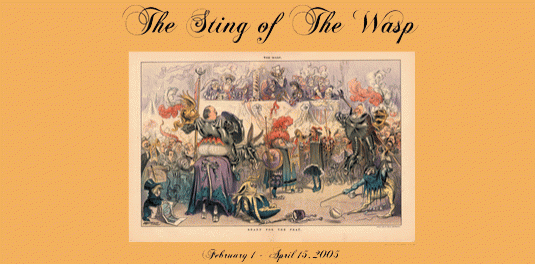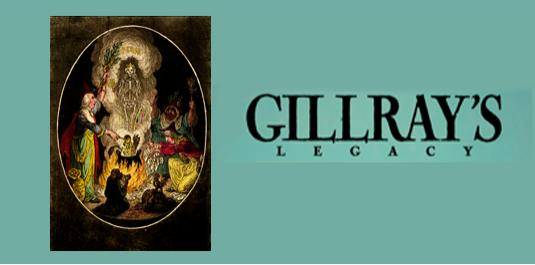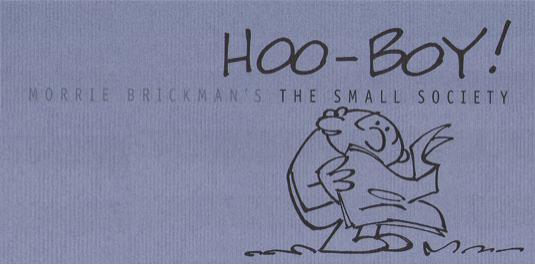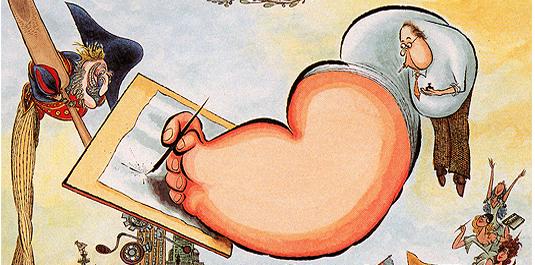Past Exhibits
 Sting of the Wasp February 1, 2005 - April 15, 2005
Sting of the Wasp February 1, 2005 - April 15, 2005 For most of the 19th century, American magazines were vast monochromatic fields of black on white. Beginning in the 1830s, a few magazines featured small hand-colored plates, but they were meager exceptions. Then, in the 1870s, thanks to the perfection of the chromolithographic process, a new breed of magazine exploding with color came to the fore. In short order, chromolithographic weeklies began popping up all over America. Outside of the famous New York weeklies, Puck and Judge, though, none lasted more than a year or two, except for one–The San Francisco Wasp.
That The Wasp endured was most improbable. Founded during the worst financial depression of the 19th century, it was expensive to produce. Published in an under-populated region of the country, it was guaranteed never to have a significant circulation. Often out of step with majority opinion, it never became the political power broker it aspired to be. Yet The Wasp was a success. It was for many years the most widely read magazine west of the Rockies. Its best cartoons compared favorably with those being published in New York. And the work of one of its editors, Ambrose Bierce, is read by more people today than are the writings of any of the editors of its more widely celebrated rivals.
 Gillray's Legacy September 15, 2004 - December 10, 2004
Gillray's Legacy September 15, 2004 - December 10, 2004 Gillray’s Legacy coincides with the 2004 Festival of Cartoon Art. Celebrating Georgian England’s greatest caricaturist as part of a twenty-first century conference focusing on censorship, self-censorship and editorial control may seem far-fetched. During an election year at a time of heightened national and international concerns, it is, however, most appropriate to remember that James Gillray was neither restrained nor genteel with his art. Some of the works in this exhibit would not be printed in a newspaper, and several others would draw angry letters to the editor.
 Hoo-Boy! Morrie Brickman's The Small Society November 2, 2003 - February 27, 2004
Hoo-Boy! Morrie Brickman's The Small Society November 2, 2003 - February 27, 2004 In 1966 Morrie Brickman created something different. The writer of a news story about the debut of the feature was undecided about whether it should be described as an “editorial comic strip” or a “political satire.” It was “both and neither,” according to cartoon historian Richard Samuel West, who continues by stating, “Even to this day, The Small Society defies neat categorization… Unlike all comic strips that preceded it, The Small Society was driven primarily by its topic for the day, not by its characters (who were generally Everyman and Everywoman), nor by a race to the punchline. Unlike the political cartoons of the period, The Small Society eschewed politicians and headlines in the particular to find the universal in public debate.”
 Arnold Roth | Free Lance: A Fifty Year Retrospective February 15, 2002 - May 17, 2002
Arnold Roth | Free Lance: A Fifty Year Retrospective February 15, 2002 - May 17, 2002 Arnold Roth: Free Lance celebrates the fun that Roth has had–and has shared with us–for more than fifty years. He knows what he wants to draw and enjoys doing it. His hand is sure and facile as it moves to create images that capture their viewer’s imagination, pictures that seem already to be completed in his mind and flow onto the page. His sens of color is subtle, adding to the drawing but never overwhelming its lines. His bravura control of watercolor, breathtaking.
 Cartoons by Leland S. McClelland: A Retrospective Exhibition February 28, 2000 - May 26, 2000
Cartoons by Leland S. McClelland: A Retrospective Exhibition February 28, 2000 - May 26, 2000 Because he is so well-known as a watercolorist, many may be surprised to know that Leland S. McClelland’s first ambition was to be a cartoonist. Drawing Attention: Pen Stroke and Perspectives from Great Lakes Chapter of the National Cartoonists Society published in 1997 includes the following autobiographical statement:
“From the time I was old enough to read the funnies I wanted to be a cartoonist on the Columbus Citizen, one of the two afternoon newspapers in the city at that time. I didn’t want to be on the Chicago Tribune or any other big papers – just the Citizen. In the summer between my two years of studying art and cartooning at the Chicago Academy of Fine Art, I took my samples in to the managing editor of the Citizen. He liked what he saw and hired me for the summer, even though I wasn’t all that good. He held the job open for me for the next year until I finished at the CAFA. I held the job until the paper went the way that so many papers did – it folded in 1959. I went to work for the city’s largest ad agency and stayed until 1964 when I quit and opened my own studio. When I left the Citizen, I started to paint watercolors which I did until I retired. I’ve always loved cartooning and cartoonists – they’re my kind of people. I’ll always consider myself a cartoonist first and something else second. “

